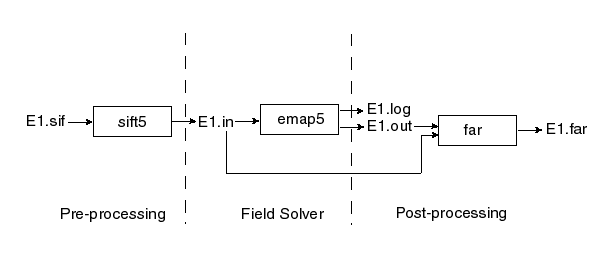
COMPONENTS OF THE EMAP5 SOFTWARE PACKAGEAs shown in Figure 1, the EMAP5 software package includes
three major components: SIFT5, EMAP5 and FAR. EMAP5 is
developed for research and educational usage. It does not
have a sophisticated mesh generator and graphic
visualization tools. SIFT5 can generate simple meshes for
users. EMAP5 is the FEM/MoM field solver. FAR is the far
field calculator.  Figure 1. Components of the EMAP5 software package.
SIFT5: The Input File TranslatorStandard Input File Translator Version5 (SIFT5) is designed to generate input files for the field solver EMAP5. SIFT5 reads a text file in the SIFT format [1]. Users can describe the structure of interest by using eleven keywords that will be discussed in a later sub-section. The physical geometry of the structure, source type and location, and the geometry of areas in which fields must be printed out by the field solver must be specified. SIFT5 detects inconsistent input parameters in input files automatically, and prompts users to correct them. The input file for SIFT5 should have a .sif suffix. The output file of SIFT5 has a .in suffix. For example, if a user has composed an input file E1.sif, the following command will generate an input file E1.in for EMAP5. % sift5 E1.sif SIFT5 has two keywords, output and default_out, to define the field of interest generated by EMAP5. The keyword "output" defines the region in which fields of interest will be printed out by EMAP5. It is usually used to generate fields in a particular region, especially in the FEM region. The keyword "default_out", on the other hand, causes EMAP5 to print all surface fields to the file, which are necessary for FAR to work properly. EMAP5: The FEM/MoM Field SolverEMAP5 is the hybrid field solver. It reads a file generated by SIFT5. The input file should have a FEM/MoM in suffix; otherwise, EMAP5 will abort and report an error message. A file with a .log suffix is generated to log running status and error mess ages. The log file was initially designed to debug the code, but users can also benefit from log messages. EMAP5 will print out fields within areas specified by the .sif file, to one or more output files. All equivalent surface currents J and M will be printed by using the keyword "default_out". An example of how to run EMAP5 follows: % emap5 E1.in EMAP5 will read the mesh file E1.in as its input. In addition, E1.log will be generated immediately as the log file. FAR: The Far Field CalculatorFAR is a program used to calculate the far field radiation pattern. The far fields are calculated from the equivalent surface currents J and M. FAR needs two input files. One is the file generated by SIFT5 using the keyword default_out, and the other is the default output file generated by EMAP5. The FAR program will prompt users to input the following parameters:
Assuming the default output file of EMAP5 is E1.out, and the input file is E1.in, the following command will run the far field calculator. % far E1.in E1.out far.out where far.out is the file to which the far field will be printed when the program terminates. The far.out file will contain an array of (q, j, Eq, Ej ) data. Eq and Ej, whose units are volts/meter, are the E fields at point (R, q , j ) in spherical coordinates. References[1] T. H. Hubing, C. Hong-Him Lim and J. Drewniak, "A Geometry Description Language for 3D Electromagnetic Analysis Codes," Proceedings of the 10th Annual Review of Progress in Applied Computational Electromagnetics, pp. 417-422, March 1994. |